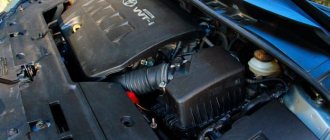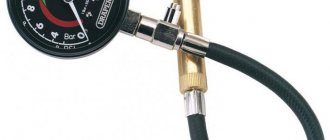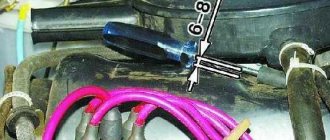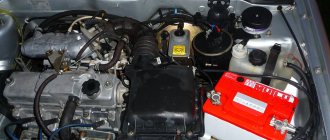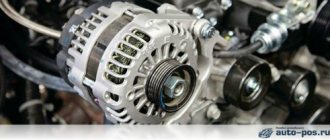The starter turns, but the engine does not start. 10 reasons
Every car owner may face the fact that one day his car will refuse to start. There can be quite a few reasons. We tried to narrow the topic and assume that you know for sure that the starter turns
and responds to the turn of the key.
1. The most banal reason
- lack of fuel. If there is no gasoline, then it is useless to start the car.
2. The funniest reason
— the exhaust pipe is tightly closed with a potato, banana, snow or rag.
3. Your carelessness
— you forgot to turn off the alarm, which blocks the fuel supply to the injector.
4. The most criminal option
— they tried to steal your car, but something went wrong.
5. The coldest reason
— the water in the fuel line, filter, gas tank is frozen.
6. Oil is out of season
, or very cold. In this case, the starter will turn, but not as fast as it should.
7. Fuel pump malfunction
. First of all, we check the fuse; if they are working, and there is no characteristic buzzing after turning the ignition key, then most likely the electric pump has burned out.
8. Malfunction of the ignition system.
In the circuit - a coil, high-voltage wires, candles - no electricity passes through. Tester to help.
9. Timing belt malfunction.
The belt broke or jumped several teeth, which resulted in a violation of the valve timing. In this case, it is better not to turn it at all, so as not to damage the valves and pistons of the engine.
10. The most destructive reason
. The connection between the starter gear and the flywheel ring teeth does not engage. Either the ring is damaged (it may simply be slipping) or the starter. In any case, when cranking the starter there will be a ringing or crunching metallic sound.
Source
The first problem is that the starter turns, but does not engage
Let's consider the following situation when the VAZ-2114 does not start, but the starter continues to turn. You should also take into account the nuance that the starter still does not engage. The mechanism of the problem is as follows:
- the key is inserted into the ignition;
- the fuel pump pumped up the fuel mixture;
- during the ignition startup process, the starter turns in idle mode (experts call this process “the starter does not catch”).
Experienced motorists note that a similar situation occurs in VAZs with high mileage, so we can talk about wear of either the starter itself or its parts. So, most often the overrunning clutch or “Bendix” suffers; the main element here is the gear. It is this overrunning clutch gear that causes a lot of trouble, because its teeth are often subject to wear. The mechanism of the malfunction appears as follows:
- the driver turns the key;
- the starter starts to spin;
- The overrunning clutch gear cannot engage the engine due to tooth wear.
Even in the starter, its gearbox may fail. This problem is less common than the previous one. This gearbox includes several types of gears, which are also subject to wear due to the long life of the vehicle. There are five gears in total:
- one small;
- three satellite gears;
- one large one, attached directly to the gearbox housing and engaged with the satellites.
Even an experienced specialist will not immediately say in which of the named parts the gear teeth have worn out. To do this, you will have to remove the starter and disassemble it to inspect all the components.
The starter turns the engine, but the engine does not start
Turning the ignition key, the driver observes the same picture every time. First, the instrument panel indicators light up to indicate the presence of fuel and battery charge. In the extreme position, the starter turns on and begins to rotate the crankshaft. To start a serviceable engine, a few crankshaft revolutions are enough, but what to do when the starter works, but the car stubbornly refuses to start? The culprit for this situation can be a variety of malfunctions, because the normal operation of the engine is ensured by several automotive systems at once.
Why does the starter spin but the car won't start?
For a successful start, a fuel supply with operating pressure, air and a timely spark are required. It is also extremely important to prepare the correct fuel-air mixture. These conditions need to be checked first when the engine refuses to start.
Burnt contact of the starter solenoid relay VAZ 2110
Difficulties with starting or its impossibility can arise for a variety of reasons. The culprits should be looked for in the following devices:
- Fuel system malfunctions for all types of engines;
- Problems in the electrical equipment of the machine.
It should also be taken into account that starting the engine in cold weather is significantly different from carrying out this operation at above-zero temperatures. We will not touch upon problems with the battery and starter; we will assume that everything is in order with them, so we will focus only on the problems of the power unit.
Starting the internal combustion engine. How does this happen?
A car engine only works if several conditions are met:
- A sufficient amount of air-fuel mixture enters the cylinders.
- At a certain moment (at the end of the compression stroke), the spark plug generates a spark of the required power.
- The crankshaft and camshaft rotate with strict interaction, ensuring timely filling of the cylinders with the combustible mixture, proper functioning of the gas distribution system and operation of the fuel pump in carburetor internal combustion engines.
By turning the ignition key, the driver supplies power to the starter solenoid relay, which turns on its electric motor and ensures engagement with the crankshaft flywheel ring gear. As the crankshaft rotates, it converts angular momentum into reciprocating motion of the pistons and drives the camshaft (or shafts). The latter ensures timely opening of the valves, due to which the combustion chambers are filled with the fuel mixture at the right time.
The engine power system is responsible for its preparation and delivery. As soon as the piston reaches the top point at the end of the compression stroke, the fine fuel mixture is ignited by the spark formed on the spark plug (in diesel units, ignition occurs due to strong air compression). After this, the micro-explosion acts on the piston, which moves down and causes the crankshaft to rotate - this is what the engine starting diagram looks like.
Why does the starter turn normally, but the engine does not catch and does not start?
In half the cases when a car refuses to start, the starter is to blame. At the same time, the other half occurs in situations where the starter regularly rotates the crankshaft, but the engine starts only after repeated attempts or is completely silent. This could be due to a variety of reasons.
Driver inattention or negligence
The notorious human factor can manifest itself in the most unexpected ways. For example, a banal lack of fuel or an alarm that blocks the fuel pump. It also happens that some “well-wisher” clogged the exhaust pipe, or a careless driver, while backing up, got stuck in a pile of soil or a snowdrift. Such reasons do not fall into the category of technical malfunctions, but they can spoil a lot of nerves.
VAZ 21124 does not start, the starter turns the engine and seizes
- Registration
- Entrance
- To the beginning of the forum
- Forum Rules
- Old design
- FAQ
- Search
- Users
So I’m asking for help, what could have happened?
If treated by pushing the car in gear
Hello everyone, I had the same problem, when it's hot it won't start when it's cold from half a turn.
I treated it like this. 1. Just in case, I changed the temperature sensor that goes to the control unit. One hundred 90 rubles, located to the right of the cylinder block on the thermostat, on the front side. It’s better to change it on a cold car, otherwise you can communicate.
2. I bought a new solenoid relay, I need to select them, they come in different types, I had one with two “ears”
Putting it in is a pain in the ass. I have protection with 5 bolts, I was too lazy to unscrew everything.
I needed an 8mm socket, a “flexible extension” (I don’t know how to put it exactly, but I bought it in a store for 40 rubles, a long time ago :p), and, accordingly, a screwdriver on which all this was put on.
I crawled up from the left front side of the engine, and using this tool it turned out to be quite easy to unscrew the two bolts.
I removed the old relay, the core remained hanging on the starter. I wanted to change it, but then I changed my mind, somehow it clings to the starter there, it’s simply impossible for me to get there, so in general I left the old one.
Then I installed a new relay, it worked without problems with the old core.
Now it always starts.
Source
Problems with the fuel system
Even the most “vigorous” battery and a new, working starter will not be able to start the car if problems arise with the supply of fuel to the cylinders. For this reason, the next thing to check is the engine power supply system.
1.Fuel pump
For carburetor and diesel engines, this unit is located directly next to the cylinder head or block. Injection power plants are equipped with an electric pump, which is installed in the fuel tank. Their operation is judged by a short buzzing sound that appears after the ignition is turned on. As for fuel pumps in carburetor engines, they are mechanically driven by a cam mounted on the camshaft.
It is easy to check the functionality of the fuel pump - to do this, remove the hose from the carburetor inlet fitting and lower it into a suitable container. After this, you should pump up the fuel using the manual pumping lever or by turning on the starter. If the result is negative, check the passage of gasoline through the fuel line and clean the mesh located in the top cover of the pump. If this does not help, then inspect the membrane and valves of the fuel pump. After replacing damaged and worn parts, the functionality of the device will be restored.
2.Fuel filters
Along the path of fuel passing from the tank to the engine there are several filter units - coarse meshes located on the fuel receiver, in the fuel pump and carburetor, and in addition, paper filters located in the section of the fuel line. The intensity and even the possibility of supplying fuel to the internal combustion engine depends on their purity. If you find a blockage, clean or replace the filter elements.
Throttle and injectors
Gasoline internal combustion engines operate on a fuel mixture, which is prepared in the carburetor or in the intake manifold (for fuel-injected cars). In the first case, the fuel passes through a whole system of channels, jets and nozzles that are located in the carburetor. In the second, it is supplied by injectors according to signals received from the electronic engine control unit (ECU).
The air supply is metered using a throttle valve, which, depending on the engine design, can be mechanically or electrically driven. Clean the parts of this assembly and the throttle itself. Also check if fuel is being supplied to the cylinders. If you are dealing with an injection car, then press the fitting spool located at the bottom of the fuel rail - gasoline should flow out from there under pressure. If the stream is too weak, then check the filters, fuel line and pressure reducing valve of the fuel pump.
In carburetor engines, the fuel supply can be judged by sharply opening the throttle - in this case, a portion of fuel will be injected from the accelerator pump nozzle into the diffuser. In addition, for gasoline power units, inspect the spark plugs - they should not be dry. Otherwise, check for the presence of a control signal at the injectors. If everything is in order with this, then you should unscrew the ramp fastening and move it away from the manifold in order to inspect the spray nozzles when starting the engine. The absence of fuel streams or their weak intensity indicates the need to clean or replace the injectors.
As for diesel engines, fuel is supplied to them under high pressure, and a much more complex pump (fuel injection pump) and specially designed injectors are responsible for this. To repair these components, special equipment is required, so in this case it is better to contact specialists.
Checking the fuel pump and fuel supply
The principles of fuel supply in carburetor and injection engine models are different, but periodically occurring malfunctions are largely similar. Fuel supply in both systems is carried out by a fuel pump. In the carburetor model it has a mechanical drive; in injection models it is an electric pump that creates high pressure in the fuel rail. Both types of pumps have built-in fuel filters, the clogging of which leads to failures when trying to start the engine.
You can indirectly determine the supply of gasoline to the cylinders by the appearance of the spark plug. If the spark plug removed from the cylinder is wet and smells of gasoline, then everything is fine with the fuel supply. However, it is better to make sure of this more reliably.
An electrically driven fuel pump may not work due to the lack of supply voltage at its terminals. The culprit for this situation may be a blown fuse or broken wires. Problems may arise due to the fault of the carburetor; clogged jets will prevent the engine from starting. But most of the problems in the fuel system are inherent in the injectors. In such systems there are several sensors that monitor and regulate the operation of the power unit. Failure of the DPKV will make starting the engine impossible. Such problems can occur due to the fault of the pressure regulator in the fuel system. Poor starting of the engine injectors cannot be excluded from the organizers.
Fuel pump VAZ 2110
On injection engines, this requires relieving pressure in the fuel system using a special valve at the end of the fuel rail. Unscrew the cap and press the valve with a screwdriver. Gasoline should squirt out from under the valve. After this, release the valve and turn on the ignition. At this time, the fuel pump must start, restoring the released pressure in the system. If the pump is silent, turn on the starter. When the pump does not operate even when the starter is turned on, there is most likely a malfunction in its power supply system.
If the pump starts working, then we check the pressure in the fuel system again, releasing it through the same valve in the ramp. Splashing gasoline again indicates that everything is in order with the fuel supply system. When gasoline does not splash and does not appear from under the valve at all, we can talk about a faulty fuel pressure regulator in the rail (constantly bleeds gasoline through the return line into the tank) or some kind of plug in the main fuel line (for example, due to freezing of water in low-quality fuel ).
Fuel pump VAZ 2110 disassembled
On carburetor engines, checking the fuel supply is much easier. It is enough to remove the air filter cover, move the throttle lever of the first chamber of the carburetor, simulating pressing the gas pedal, and see if gasoline sprays from the spray nozzle. You can pump gasoline into the carburetor using the manual pumping lever, which is found on all mechanical gasoline pumps.
VAZ won't start? Causes, elimination
I often encountered a problem when a VAZ would not start. Owners of injection and carburetor cars contacted us. Below I will list common causes that should help with your problem. Before that, it’s only worth saying that below we will talk about both old and new models. The material is voluminous, because I decided to describe everything in detail.
There are three main reasons why a domestic car does not want to start:
- Lack of fuel in the combustion chamber
- Lack of oxygen
- No ignition
As a rule, 80 percent of malfunctions lie in these three reasons. Let's take a closer look.
Ignition problems
The most common malfunction. The spark itself may exist, but its strength is not sufficient to ignite the fuel mixture. To identify the problem, the first step is to check the spark plugs.
In case anyone doesn't know, spark plugs can be found by the wide wires coming from them. We need to determine which candle has failed, because they cannot all break at once. To check, you need to start the VAZ engine and listen to the sound of its operation. Next, we unscrew the spark plugs one by one and listen to how the sound of the engine changes. When you remove a faulty spark plug, the sound of the engine will not change.
Inspect the unscrewed spark plug. By the carbon deposits on it you can determine why it failed. Most likely, the electrode will have one of the following deposits:
- Of red color. Occurs due to the addition of various additives to car fuel. If you see this type of carbon deposits, then you should refuse additives, because soon you will have to change the remaining spark plugs.
- White (similar to plaque). Indicates that the fuel mixture is unbalanced. This means that it is formed in the wrong oxygen/fuel ratio. There may be either an excess of fuel or an excess of oxygen.
- Matt black color. Occurs due to an excess of gasoline in the fuel mixture. Reason: the carburetor is incorrectly adjusted or the injector is not working correctly. Another symptom: increased fuel consumption.
- Oil black. Logically, this indicates increased oil consumption, which gets onto the electrode and interferes with the formation of a spark.
It is important to know! The spark plugs may be outwardly in good working order and the lack of a spark may be caused by filling the spark plug electrode with gasoline. This occurs due to a low battery charge.
Fuel system problems
Among the elements of the fuel system, the following factors influence engine starting:
Also included in this category are electrical components that are directly related to the fuel supply. This is an electric fuel pump and a fuel pump relay.
Before checking other methods, you must be completely sure that the VAZ 2114 with an injector is filled. “Yes, there are still five liters there” according to the indicator on the tidy or “I filled it up yesterday, I couldn’t spend that much” are not suitable. The gauge may be lying, and there may be leaks in the tank or fuel lines. Carefully check the car for fuel leaks; just in case, fill in 5-7 liters of gasoline from a canister.
The mesh in the tank rarely gets clogged, leave this option for last, but it’s worth trying to change the fine filter if electrical problems are ruled out.
The operation of the fuel pump is checked by ear (after turning the key, its operation should be heard; if not, the pump has “died”, or the pump relay, or a wiring break). According to the manual, you need to connect a pressure gauge to the fuel system. If the pressure does not stay within 2-2.5 atm, the VAZ 2114 will not catch due to insufficient fuel pressure.
Faulty starter
The problem with the starter on VAZs is very relevant. According to statistics, before a major overhaul of the engine, there is a need to repair the starter at least once. After checking the spark plugs, I advise you to pay attention to this mechanism and most likely the fault will lie there.
To determine the problem, you need to determine what type it is:
It is very easy to determine: if the starter does not turn and the VAZ does not start, then the problem is in the electrics. If you hear it spinning, then there is a mechanical problem. Let's figure out what can break down in the starter's electrics and what can go wrong in the mechanics.
Checking the contact.
Start checking with the simplest thing: inspecting the terminals on the mechanism body. Due to our “great” weather conditions, they like to oxidize, causing contact to be lost. As a result, the control impulse does not reach the motor and when we turn the ignition key we hear nothing. To clean the terminals, a regular fine knife or natfel will do.
Advice: to avoid corrosion of the terminals, you should treat them with lithol. It is first necessary to clean off any pockets of corrosion.
During the test, you will be able to confirm that there is no open circuit: each wire should be fixed to the starter terminals. Without diagrams on all VAZ models, the connection is similar:
- One “plus” from the battery goes to the starter terminal
- The second “plus” comes from the ignition switch through the fuse box
Check the fuse box, as a blown fuse breaks the circuit and no control voltage is supplied to the starter. Just visually check the fuse and if you see that it has burned out, replace it.
Checking the serviceability of the retractor
relay. This device is responsible for extending the bendix. Diagnosing a malfunction of the solenoid relay is easy, since it operates with a characteristic clicking sound.
Electrical faults
Most of the problems lie here, so we’ll look at each option in detail here:
Nothing happens when I turn the key
On a VAZ 2114, this usually indicates a violation in the ignition switch - starter line, but one of the reasons for the breakdown “for blondes” is a dead battery, do not forget about it (checked with a voltmeter: it should be at least 11.8 V - and with a hydrometer, if the battery is serviceable : at least 1.22 in each jar).
Let's move on. The cause of such a malfunction may be a breakdown of the ignition switch cylinder, and the injector has nothing to do with it. If, when turning the key, new sensations arise (something catches, turning has become easier or, conversely, more difficult), that’s the problem.
Under the panel, approximately above the clutch, there are two relays: ignition switch and starter release. The reason may be a malfunction of one of them. They are checked according to the manual by a good electrician or replaced with a known working one.
Starter. Often the cause may be a jammed “retractor”. If you are standing in a field, you should try hitting it with something heavy like a large key (without fanaticism) - it may help. If the car is parked in a garage, you should remove the starter and try to start it directly from the battery.
To do this, press the housing to the zero terminal of the battery, install the wire with the alligator clip on the positive terminal of the battery and bring it to the positive of the retractor. If the starter tries to jump out of your hands, everything is fine (be careful, it is not recommended to carry out this procedure without basic knowledge of safety precautions and an assistant!).
If there is no reaction, the problem is in the retractor. If the relay buzzes, but the starter does not turn, the problem is in the brushes. If the starter makes a terrible sound, but does not turn, the problem is in the bendix.
If the starter turns, replace the battery and check the power supply to the chips that are connected to the starter (with an assistant, one turns the key, the other measures it with a multimeter).
Also pay attention to the ground wire that goes to the battery. If there are breaks in the wiring at the point of contact with the body or at the terminal, it must be replaced. It is also worth disconnecting the wire from the body and thoroughly cleaning it with a metal brush. The reason for the failure to start may be simple oxidation.
The starter turns, but the car does not start
This is the most common situation in the case of the VAZ 2114. The procedure for solving it must begin with answering the question of whether there is a spark. To do this, take an assistant, unscrew one spark plug, put an armor wire on it and very carefully (avoid touching live parts, hold the insulated part of the wire) apply the spark plug to the cylinder head cover. While the assistant turns the engine, watch the behavior of the spark plug. If there is no spark, you need to look for it.
If there's no spark
The ignition module is one of the key problems of the VAZ 2114 on the injector. It breaks often and sometimes a new one comes with a defect. You can read more about checking the ignition module in other material on our website. Please note that the problem may also lie in the chip that is connected to the module. The presence of power on it must also be checked.
DPCV is another reason why there may be no spark. Since this sensor monitors the firing phases of the cylinders, it is one of the key elements of the ignition system. Note that the probability of its failure is lower than that of the ignition module. It is checked by an electrician using an oscilloscope; garage methods do not provide an accurate assessment of the condition of the sensor (only replacement with a guaranteed working one).
ECU. “January” is a relatively reliable injector, but the “brains” can also malfunction from time to time. Often the problem with them is identified by a violation of the injection phases: for example, a spark is supplied only to cylinders 2 and 4, or only to cylinders 1 and 3. Sometimes the issue can be resolved by simply cleaning the contacts on the ECU chip; it is also subject to oxidation, which causes signal loss.
Fuel pump malfunction
With this malfunction, the Zhiguli engine starts, and then stalls or does not start at all. The first step is to check whether the fuel pump fuse is working properly, because according to statistics, 60 percent of VAZ fuel pump failures are associated with a blown fuse. In VAZ 2105 it is located in a block under the hood near the windshield, in VAZ 2107, 2109, 2115 in the cabin below the dashboard. In VAZ 2110, 2111 and 2112 it is located in the cabin in the place of the front passenger's feet. Next to the fuses there are relays, which are also responsible for the operation of the fuel pump. If the fault is not in the fuse or relay, then it lies either in the fuel pump itself or in its power supply circuit.
In carburetor VAZs, the fuel pump is located in the engine compartment next to the cylinder head.
All “classics” such as the Zhiguli were equipped with a fuel pump called DAAZ. Its catalog number is: 1106010. The part is very reliable, so the likelihood that the problem is with it is not high. And even if it breaks, you can buy repair kits.
In injection VAZs with a fuel pump, everything is not so fabulous.
It is hidden in the gas tank and likes to fail if there is little fuel inside. The pump motor is electric and is cooled by the gasoline itself, in which it is located. If there is little gasoline, the pump does not cool well, overheats and eventually breaks down.
The car may have difficulty starting due to low fuel content in the tank.
VAZ 2114 does not start, spark plugs are dry
If the VAZ 2114 does not start, first of all we unscrew the spark plugs.
The fact that they are dry indicates that fuel is not supplied to the cylinders. If there is a spark, then we immediately discard the crankshaft position sensor, because the control unit definitely understands the position of the cylinders at the moment of time, since it supplies a spark to the spark plugs. To begin with, turn on the ignition and listen to whether the fuel pump is working. If the fuel pump does not work, then first of all we check its fuse. In addition, it is worth paying attention to whether the fuel pump relay clicks after turning on the ignition. If this is not the case, then the problem is most likely in the ignition switch, or the relay itself is faulty. If the relay clicks, this indicates that the fuel pump activation circuit is closed. Then you need to check the voltage at the relay, after which we remove the back seat, remove the chip from the fuel pump, turn on the ignition and measure the voltage at the chip. In general, the fuel pump chain runs through the cabin, so rarely anything happens to it. From this we conclude that the fuel pump most likely simply burned out. After the replacement everything will return to normal.
If the VAZ 2114 does not start, the fuel pump is running, the starter is turning, then you need to pay attention to whether there is fuel in the fuel rail. For this purpose there is a special spool, which is closed with a black cap. After turning on the ignition, you need to press on this spool; fuel should flow out of the ramp. If this does not happen, then we check either the fuel pressure regulator by squeezing the return line to the fuel tank, or change the fuel filter. Ideally, you need to screw a pressure gauge onto this spool, which will show the pressure in the fuel rail. It should be 3.2 atmospheres after turning on the ignition. If you clamp the return line, the pressure should be at least 6 atmospheres.
When we are sure that there is pressure in the fuel rail, we need to make sure that the injectors open. To do this, remove the chip from any injector, and then add voltage to the red-pink wire with the ignition on. This is a general plus. It is constant on the injectors. If 12 volts is not observed on this line, then we go look in the control unit.
Crankshaft position sensor
The sensor itself is very reliable, and there is nothing to break there. However, it can become clogged with a thick layer of dirt and stop functioning. The way out of the situation is simple: just wipe it. As a rule, it cannot become dirty immediately and the problem will manifest itself gradually: at first your VAZ does not start well, and after a month the car is no longer able to start.
Since a lot of dirt accumulates on this sensor, its contact with the wire simply rots. This is already a common problem, but it can be easily solved by manually restoring contact. The crankshaft sensor is located on the oil pump.
It is important to know! It is not permissible to make contact using twists. So you will lose it in a month, so it is best to solder the contact and cover it with lithol.
VAZ starts and immediately stalls
The car may stall immediately after starting, even due to trivial little things such as consumables. Therefore, first of all, I advise you to check the fuel and air filters. If they are clogged, it is difficult for the engine to receive oxygen and fuel, which causes it to simply stall.
If before your VAZ stopped starting, the following were discovered:
- Power Loss
- The car doesn't start well
- Increased fuel consumption
It is most likely that the catalyst that is equipped with VAZ injection models is faulty. The catalyst can be removed by flashing the engine control unit. As an alternative: install lambda decoys. A clogged catalyst may also be the reason why the VAZ does not start.


